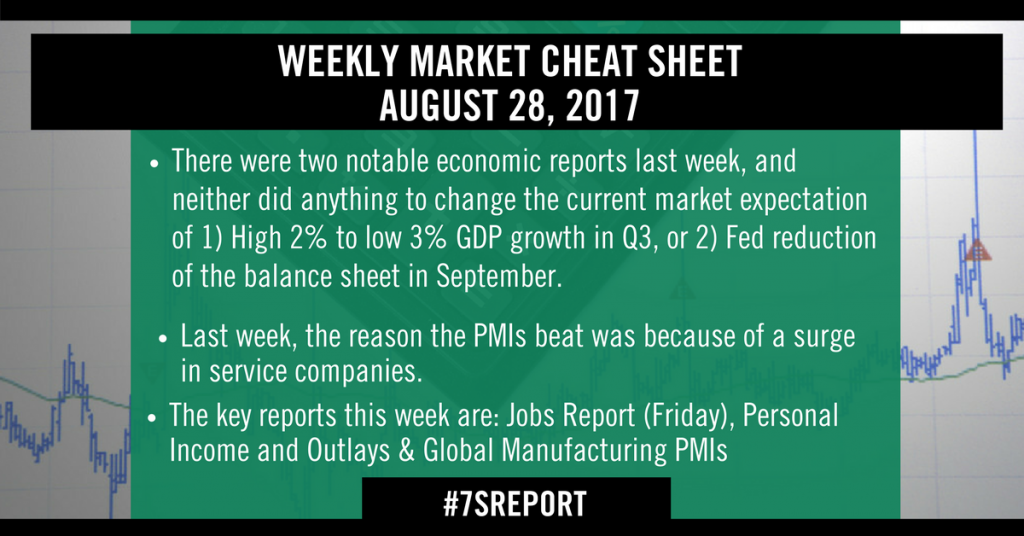Weekly Market Cheat Sheet, August 28, 2017
Last Week in Review
There were only two notable economic reports last week, and neither were particularly controversial… and neither did anything to change the current market expectation of 1) High 2% to low 3% GDP growth in Q3, or 2) Fed reduction of the balance sheet in September.
Neither data point gave us any incremental color on whether the Fed will hike rates in December, although
we’ll get a lot more color on that issue this week. Looking at the data, the most important number last week was the August flash composite PMIs. The headline number beat at 56 vs. (E) 54.3, but that strong aggregate number hid some pretty significant discrepancies in the details.
The reason the PMIs beat was because of a surge in service companies. Flash service sector PMI rose to 56.9 vs. 54.8. But, the more important manufacturing PMI dropped to 52.5 vs. 53.2 (the manufacturing PMI is just a better reading of activity, so it’s more heavily weighted in the minds of economists).
So, despite the headline beat, this number was actually a disappointment, although I want to be clear that it was not an outright negative (PMIs need to drop below 50 before they imply economic activity is slowing). Bottom line, this is not the type of August reading that would make us think we’re seeing an economic acceleration.
Turning to Durable Goods, they were in line. Yes, the headline reading missed expectations as orders for Durable Goods fell -6.8% vs. (E) -5.8%. But, longer-time readers of this Report know you should ignore the headline as it’s massively skewed by airplane orders. The more important number is New Orders for Non-Defense Capital Goods ex Aircraft (NDCGXA) and it rose 0.4% vs. (E) 0.5%, although June data was revised 0.1% higher, so it was an in-line reading.
Again, we watch NDCGXA because it’s the best proxy for business spending and investment. And, similar to the flash PMI, while the number isn’t an outright negative, it’s not the kind of number that makes us think a broad economic acceleration is coming.
Bottom line, both numbers last week implied continued steady, but unspectacular, economic growth, and that’s simply not enough to cause a rising.
This Week’s Preview
This will be one of the busiest weeks of the year from an economic data standpoint, and it will come during one of the lowest liquidity weeks of the year… so the potential for data-based volatility this week is high.
The key reports this week (in order of importance) are: Jobs Report (Friday), Personal Income and Outlays (Thursday) and Global Manufacturing PMIs (Thursday night/Friday morning).
The reason those reports are ranked like that is because of inflation. Remember, barring a shockingly week Jobs Report on Friday, nothing is going to stop the Fed from reducing the balance sheet in September.
But, whether they hike rates in December remains uncertain, and the key variable that will decide that is inflation. So, that means that the wage number in Friday’s Jobs Report, and the Core PCE Price Index (the Fed’s preferred measure of inflation, which is contained in the Personal Income and Outlays report) will be the two key numbers this week.
If they run hotter than expected, you will see markets begin to price in the chance of a December rate hike, which would likely be a near-term headwind on stocks as a rate hike is not priced in to bond yields, the dollar or equities.
Turning to measures of economic growth, the August manufacturing PMIs are always important, but again there really shouldn’t be any major surprises here. A firm number in the US that refuted the soft flash PMI from last week would be welcomed as we need better growth to push stocks higher, but really the focus will be on inflation this week.
Looking at the dovish possibilities, we could easily see the data this week push the 10-year Treasury yield to new lows if the inflation data is underwhelming, and we would view that as a negative for stocks broadly.
Bottom line, I know this is a heavy vacation week, but it’s important one for Fed and ECB expectations, and that has the potential to move markets, especially given the precarious technical situation the S&P 500 is sitting in.
Time is money. Spend more time making money and less time researching markets every day. Subscribe to the 7sReport.com.

